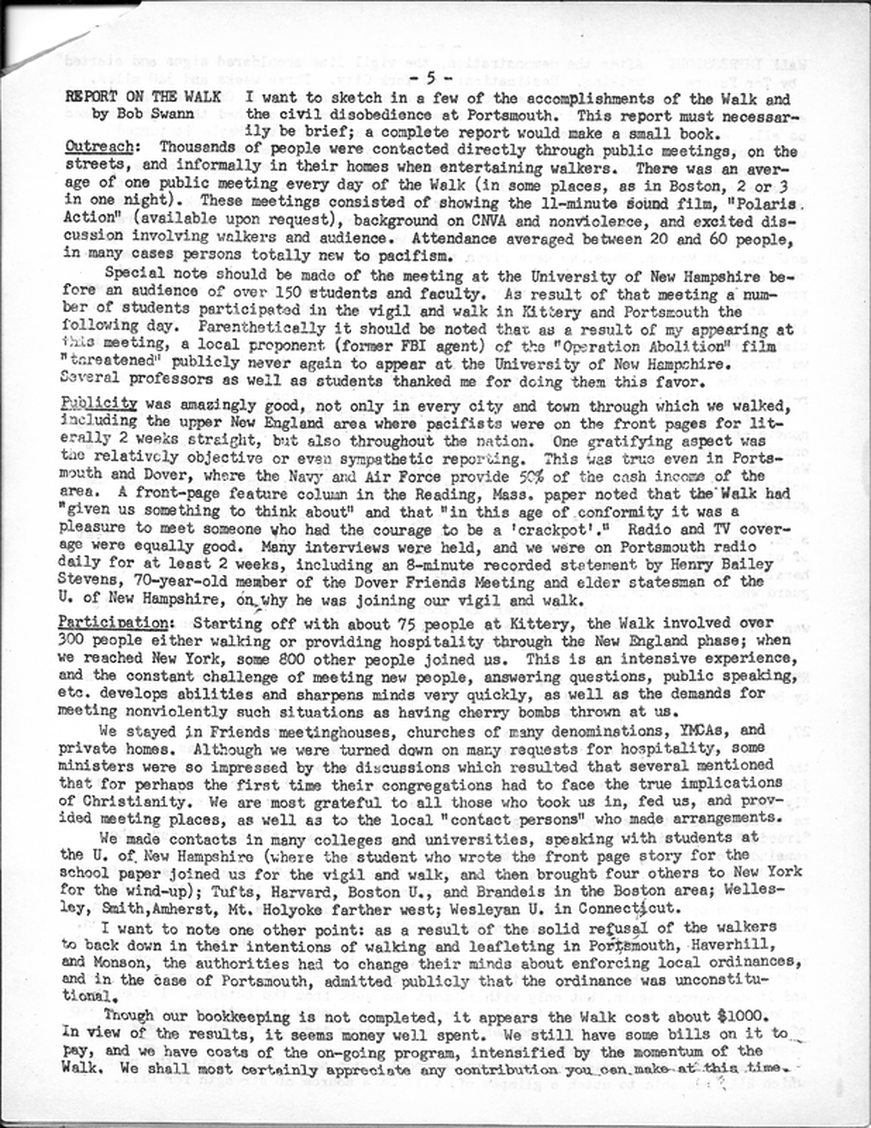|
In solidarity with the 1960-1961 San Francisco to Moscow Walk for Peace, one of the longest and most ambitious peace walks in modern history, many companion walks were organized throughout the United States and Europe. The New England Committee for Nonviolent Action (NECNVA), based at VPT in Voluntown, Connecticut, organized the New England companion walk which started in Kittery, Maine and passed through cities in New Hampshire, Massachusetts, and Connecticut before ending at the UN Building in New York City. Along the way, hundreds of people participated either as walkers or providers of hospitality, and thousands more heard the NECNVA message: that the US military plans during the Cold War were both ethically and strategically compromised. By many measures, the “3-Week Walk for Peace” through the Northeastern US in 1961 was a massive success. (See our previous posts: “Organizing the San Francisco to Moscow Walk for Peace (1960-1961)” “‘Call to a 3-Week Walk for Peace’ (1961)”) Shortly following the action, one of the NE CNVA founders, Bob Swann, wrote a brief report about the walk. He divided his report into three main sections: “Outreach,” “Publicity,” and “Participation.” Through his words, we can glimpse some of the smart organizing that may have contributed to the walk’s success. For example, Bob Swann recounts that the walkers held on average one public meeting every evening, in which an average of 20-60 people would attend. These meetings offered multiple ways for people to engage with the CNVA message: by watching a film, participating in discussion, or just actively listening. The walk also enjoyed much positive publicity in the newspapers, radio, and television news. One factor may have been the explicitly nonviolent behavior of these activists, and another, the quality of responses given in the many interviews conducted along the walk. But one crucial factor — and one that many modern activist groups sometimes overlook — seems to have been the fact that the NE CNVA purposely connected with some locally respected figures who agreed with the NE CNVA program to help lend legitimacy to the cause. Reaching the local community by having the area’s religious, academic, or otherwise culturally important leaders articulate the CNVA message proved to be a very effective strategy. But the walkers were not limited in spreading their message to just these public meetings. Along the walk, there were countless opportunities for spontaneous discussion: with bystanders as the participants walked; during breaks and at evenings with those providing hospitality; at universities, places of worship, community centers, and more. Indeed, the infinite opportunities to spread the message up close was one of the great strategic strengths of the 3-Week Walk for Peace and for other such peace walks in general. See below to read the report and determine for yourself why the walk was so successful. (Click the images below to download the PDF version of the original clippings) --
Take Action The CT Committee for the Prohibition of Nuclear Weapons organizes pro-disarmament demonstrations throughout the year. To participate in these demonstrations against nuclear arms and in support of the UN’s Treaty on the Prohibition of Nuclear Weapons, please get in touch with us on Facebook at facebook.com/voluntownpeacetrust or email us at [email protected]. — Support Us If you like our weekly posts, please consider supporting this project with a one-time or recurring donation. Contributions of all sizes are appreciated. Click this link to learn more about what we do and how you can donate: https://www.mightycause.com/organization/Voluntown-Peace-Trust — Source Swann, Bob. “Report on the Walk.” Polaris Action Bulletin. 10 April 1961 (Bulletin #21), page 5. Comments are closed.
|
AuthorWrite something about yourself. No need to be fancy, just an overview. Archives
March 2023
Categories |


 RSS Feed
RSS Feed